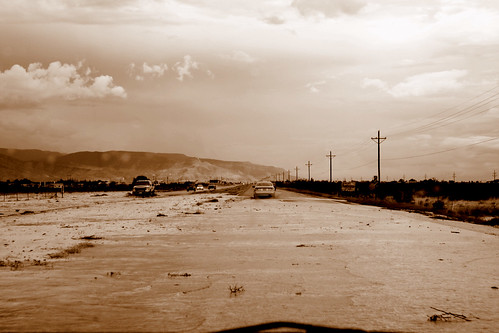Summer is a great season but it can also be deadly. Between fires, more people out on the roads, and the threat of powerful thunderstorms and tropical storms, drivers need to exercise caution. Flash floods are particularly deadly. They can occur during or after a heavy downpour and. If the rain falls on soil that is already saturated with moisture, the runoff collects in ditches and can quickly rise to the level of the pavement. Parched dry areas and particularly prone to flash flooding, which claim the lives of many pedestrians and motorists each year.
Extra precautions should be taken when driving in an area experiencing heavy rainfall. Flash floods can occur unexpectedly and flow with tremendous force. Many drivers underestimate the kinetic energy of flowing water and what it can do to overpower a passenger vehicle.

Know Your Routes
In and around the familiar neighborhoods, motorists should learn of the alternate routes to and from home, work, and shopping areas. Flash floods can occur nearly anywhere and do not always overrun a roadway in the same location. It is extremely important to drive more slowly during a heavy downpour, especially at night when visibility is poorer. Take a note of where creeks, washes, and rivers flow as those can be particularly dangerous areas.
A flooded roadway is often difficult to see unless emergency personnel have already set up barricades. Remember that unfamiliar roads may look to be well protected by drainage ditches and yet can have a weak point unknown to the occasional traveler. Always know about alternate highways and byways when preparing an out-of-town trip.
Avoid Flooded Roadways
If water is running over a paved or dirt road, do not attempt to cross over the flood. The depth of the water is very difficult to determine in most cases. There may also be unseen potholes, tree limbs or debris hidden under the torrent.
Motorists who come upon warning signs or barricades should turn back and follow an alternate route. This is true even if no water is visible on the roadway ahead. Flash floods often come in surges, separated by minutes or even hours of dry roadway. Most people who die in flash floods are drivers and passengers trapped in their vehicles after being caught in an unexpected water surge, which can even occur many hours after it has stopped raining.
What To Do If Caught
Motorists who find themselves stalled in a flooded roadway should remain calm and keep the vehicle doors closed. If the engine cuts off, do not try and restart it. Even if the engine catches and holds, the chances of irreparable damage is high.
If the water has reached the lower level of the passenger or driver doors, opening them will create a possible surge into the vehicle. It is advisable to keep them shut and open the windows instead. Escaping the vehicle through the windows is much safer than opening one of the doors because a sudden surge can sweep away the vehicle.
Driving Through Running Water
Drivers often encounter a flash flood unexpectedly, with water rising up to the level of the chassis within seconds. If this occurs, drivers are encouraged to slow down and keep the vehicle pointed forward. So long as the engine is running, the best bet is to take it slow and continue along the roadway.
The one exception to this rule is when debris can be seen ahead on the roadway. If there is no way to continue forward, it is best to stop the vehicle, shut off the engine and leave the area on foot. Even if you have a vehicle with a higher driver position such as a truck or SUV, don’t underestimate the power of water.
High Speed Kills
Some drivers attempt to hydroplane their way across deep water. The assumption that the vehicle will ride high is correct. However, the tires are no longer touching the road surface, and the current will quickly spin the vehicle and carry it off the roadway.
Drivers and passengers should also be aware of possible downed power lines in flooded areas. High winds that accompany thunderstorm cells often bring down power poles. Water is an excellent conductor of electricity, and drivers should never consider taking their vehicle through water that is exposed to live wires.
This post was written by Jason Nelson on behalf of the website http://www.discountcarinsurancequotes.net helping drivers drive safer and save on their insurance rates. Go to their site now to compare rates and obtain free quotes.
